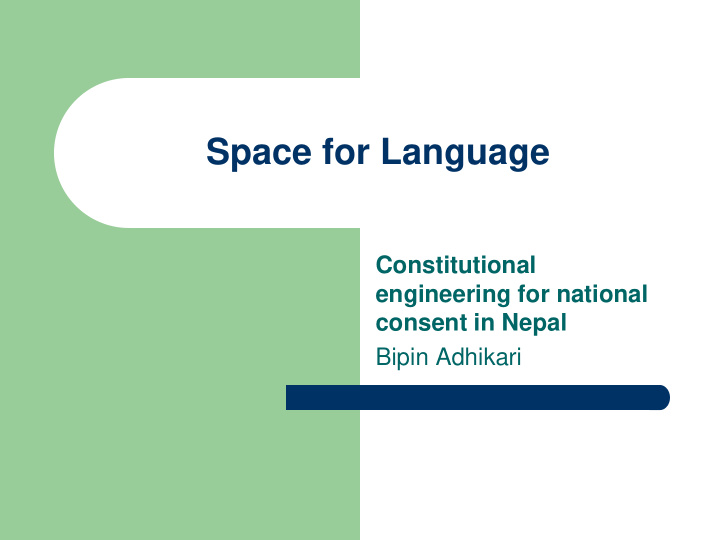



Space for Language Constitutional engineering for national consent in Nepal Bipin Adhikari
Linguistic human rights concern the individual and collective rights to choose the language or languages for communicating in a private or public atmosphere, regardless of ethnicity, nationality or the number of the speakers of a language in a given territory.
Linguistic human rights concern … Linguistic rights include the right to legal, administrative and judicial acts, education, and the media in a language understood and freely chosen by those concerned. They are a means of resisting forced cultural assimilation and linguistic imperialism, especially in the context of protection of minorities and indigenous peoples.
Linguistic human rights concern … Linguistic rights in international law are usually dealt in the broader framework of cultural and educational rights.
Important documents for linguistic rights include the Declaration on the Rights Persons Belonging to National or Ethnic, Religious and Linguistic Minorities, and instruments related with minority rights, rights of indigenous people, and so on
Status of Languages in Nepal Nepal is a multiethnic, multi-religious multi- lingual country with more than 92 languages. The estimated present population of Nepal is 28,563,377.
Status of Languages … According to the census of 2001, 47.8% speak Nepali, 12.1% Maithili, 7.4% Bhojpuri, 5.8% Tharu (Dagaura/Rana), 5.1% Tamang, 3.6% Newar, 3.3% Magar, 2.4% Awadhi, 10% other, and 2.5% unspecified.
Status of Languages … Nepal's diverse linguistic heritage evolved from its major language groups: Indo-Aryan, Tibeto-Burman, Mongolian and various indigenous language isolates. Nepali is the sole official language of Nepal. It comes from the Indo Aryan Group.
Language policy It was 1951, when the Nepalese monarch ended the century-old system of rule by hereditary premiers and instituted a cabinet system of government with the help of democratic forces.
Language policy The Nepali language - also known as Gorkhali or the khasa kura - in the Devnagari script continued to receive the patronage of the state in Nepal even after 1950_51. With the unification of Nepal during the last quarter of the Seventeenth century, Nepali vernacular quickly became a regal or state language.
Language policy … Constitution of Nepal 1947 The Interim Constitution of 1951 The Constitution of the the Kingdom of Nepal 1959 The Constitution of Nepal 1962 The Constitution of the Kingdom of Nepal 1990
Interim Constitution of 2007 Article 5 of the Interim Constitution laid down: (1) All the languages spoken as mother tongues in Nepal are the national languages of Nepal. (2) The Nepali language in the Devanagari script shall be the language of official business.
Interim Constitution of 2007 … Notwithstanding whatever is written in clause (2), the use of one's mother tongue in a local body or office shall not be barred. The State shall translate the language used for such purposes into the language of official business for the record.
Interim Constitution of 2007 … Article 17 of the interim constitution has guaranteed each community - (1) the right to receive basic education in their mother tongue as provided for in the law. (2) the right to receive free education from the state up to secondary level as provided for in the law (3) the right to preserve and promote its language, script, culture, cultural civilisation and heritage.
Current Issues While the Constituent Assembly of Nepal is busy in the constitution making business, there is intense debate in the house and outside about the treatment to be given to the language issues in terms of policy changes and institutional framework for the protection, maintenance and promotion of all of these languages equally. The major issues are -
Current Issues … How many official languages should Nepal have? What does official language status actually mean? In what sense non-official languages are non-official? How can constitutional design respond to linguistic diversity in a country which has more than 93 languages?
Current Issues … The scope for linguistic choice for the national and provincial units and the consequences of those choices The relationship between official language policies and federalism linguistic reorganization of the districts, zones or provinces? Capacity related issues
Proposed constitutional designs, institutions and processes Nepali to continue as the national official language all native languages spoken in Nepal are national languages.
Proposed constitutional designs, institutions and processes … each province has been given the competence to decide how many provincial languages it wants as its official languages. The local units within the provinces may also employ the local language of the area as the official language for their particular region as per the law enacted by the respective provincial legislature.
Proposed constitutional designs, institutions and processes … None of these provisions, however, are deemed to restrain anybody from the use of his or her native language to receive public services from the state. Although it will be necessary to define the nature of this last provision by law, the first three provisions are clear enough and mostly address many of the demands of Nepal's natives.
official language of the central government shall be the language to be employed for the communication between the centre and the provinces. There are two exceptions, however. First, a province may decide to communicate with the centre in one of the languages it has approved for official business within the province.
Proposed constitutional designs, institutions and processes … Secondly, the provinces are to conduct their official business with each other in the official language of the centre and any other language to be mutually agreed upon between them. The provision of language commission Net effect
Recommend
More recommend